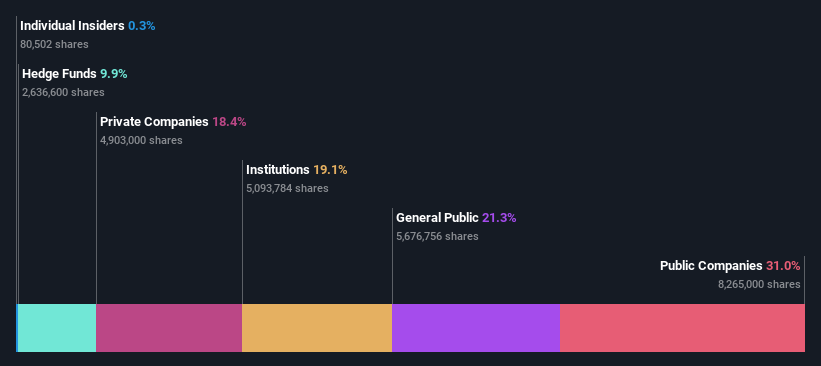- Japan
- /
- Gas Utilities
- /
- TSE:1663
K&O Energy Group Inc.'s (TSE:1663) biggest owners are public companies who got richer after stock soared 9.9% last week

Key Insights
- Significant control over K&O Energy Group by public companies implies that the general public has more power to influence management and governance-related decisions
- A total of 4 investors have a majority stake in the company with 59% ownership
- Institutional ownership in K&O Energy Group is 19%
If you want to know who really controls K&O Energy Group Inc. (TSE:1663), then you'll have to look at the makeup of its share registry. And the group that holds the biggest piece of the pie are public companies with 31% ownership. That is, the group stands to benefit the most if the stock rises (or lose the most if there is a downturn).
Clearly, public companies benefitted the most after the company's market cap rose by JP¥8.4b last week.
Let's delve deeper into each type of owner of K&O Energy Group, beginning with the chart below.
Check out our latest analysis for K&O Energy Group

What Does The Institutional Ownership Tell Us About K&O Energy Group?
Institutions typically measure themselves against a benchmark when reporting to their own investors, so they often become more enthusiastic about a stock once it's included in a major index. We would expect most companies to have some institutions on the register, especially if they are growing.
K&O Energy Group already has institutions on the share registry. Indeed, they own a respectable stake in the company. This implies the analysts working for those institutions have looked at the stock and they like it. But just like anyone else, they could be wrong. When multiple institutions own a stock, there's always a risk that they are in a 'crowded trade'. When such a trade goes wrong, multiple parties may compete to sell stock fast. This risk is higher in a company without a history of growth. You can see K&O Energy Group's historic earnings and revenue below, but keep in mind there's always more to the story.

Our data indicates that hedge funds own 9.9% of K&O Energy Group. That catches my attention because hedge funds sometimes try to influence management, or bring about changes that will create near term value for shareholders. The company's largest shareholder is GODO SHIGEN Co., Ltd., with ownership of 18%. Air Water Inc. is the second largest shareholder owning 17% of common stock, and Keiyo Gas Co., Ltd. holds about 14% of the company stock.
On looking further, we found that 59% of the shares are owned by the top 4 shareholders. In other words, these shareholders have a meaningful say in the decisions of the company.
Researching institutional ownership is a good way to gauge and filter a stock's expected performance. The same can be achieved by studying analyst sentiments. There is a little analyst coverage of the stock, but not much. So there is room for it to gain more coverage.
Insider Ownership Of K&O Energy Group
While the precise definition of an insider can be subjective, almost everyone considers board members to be insiders. Company management run the business, but the CEO will answer to the board, even if he or she is a member of it.
Most consider insider ownership a positive because it can indicate the board is well aligned with other shareholders. However, on some occasions too much power is concentrated within this group.
Our most recent data indicates that insiders own less than 1% of K&O Energy Group Inc.. However, it's possible that insiders might have an indirect interest through a more complex structure. It appears that the board holds about JP¥283m worth of stock. This compares to a market capitalization of JP¥94b. Many tend to prefer to see a board with bigger shareholdings. A good next step might be to take a look at this free summary of insider buying and selling.
General Public Ownership
With a 21% ownership, the general public, mostly comprising of individual investors, have some degree of sway over K&O Energy Group. While this group can't necessarily call the shots, it can certainly have a real influence on how the company is run.
Private Company Ownership
We can see that Private Companies own 18%, of the shares on issue. It's hard to draw any conclusions from this fact alone, so its worth looking into who owns those private companies. Sometimes insiders or other related parties have an interest in shares in a public company through a separate private company.
Public Company Ownership
We can see that public companies hold 31% of the K&O Energy Group shares on issue. This may be a strategic interest and the two companies may have related business interests. It could be that they have de-merged. This holding is probably worth investigating further.
Next Steps:
While it is well worth considering the different groups that own a company, there are other factors that are even more important. To that end, you should learn about the 2 warning signs we've spotted with K&O Energy Group (including 1 which is a bit concerning) .
If you would prefer discover what analysts are predicting in terms of future growth, do not miss this free report on analyst forecasts.
NB: Figures in this article are calculated using data from the last twelve months, which refer to the 12-month period ending on the last date of the month the financial statement is dated. This may not be consistent with full year annual report figures.
Valuation is complex, but we're here to simplify it.
Discover if K&O Energy Group might be undervalued or overvalued with our detailed analysis, featuring fair value estimates, potential risks, dividends, insider trades, and its financial condition.
Access Free AnalysisHave feedback on this article? Concerned about the content? Get in touch with us directly. Alternatively, email editorial-team (at) simplywallst.com.
This article by Simply Wall St is general in nature. We provide commentary based on historical data and analyst forecasts only using an unbiased methodology and our articles are not intended to be financial advice. It does not constitute a recommendation to buy or sell any stock, and does not take account of your objectives, or your financial situation. We aim to bring you long-term focused analysis driven by fundamental data. Note that our analysis may not factor in the latest price-sensitive company announcements or qualitative material. Simply Wall St has no position in any stocks mentioned.
About TSE:1663
K&O Energy Group
Engages in the development, production, supply, and sale of natural gas and iodine in Japan.
Flawless balance sheet with proven track record and pays a dividend.


